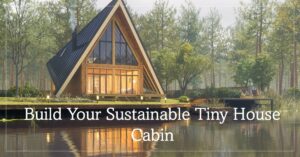The Ultimate Guide to Finding the Biggest Tiny House Builders in the USA
Welcome to the fascinating world of tiny houses, where small spaces pack a big punch! The tiny house movement has been sweeping across the United States, capturing the hearts and dreams of people looking to downsize, simplify, and embrace a more sustainable lifestyle.
You’ve come to the right place if you’re one of those dreamers. This guide will help you navigate the exciting journey of finding the perfect tiny house builder to bring your dreams to life
Understanding the Tiny House Market in the USA
Before finding the right builder, let’s set the stage. Tiny houses have gained remarkable popularity in recent years. From cozy cabins to sleek, modern designs, there’s a tiny home for every taste. Not only do these diminutive dwellings help reduce your carbon footprint, but they also offer financial freedom and a chance to embrace a clutter-free life.
In the USA, the tiny house movement has given rise to various tiny house styles and types to suit different preferences and needs. Here are some of the most common types of tiny houses available:
Traditional Tiny Houses on Wheels (THOWs):
● These are the most iconic tiny houses. They are typically built on trailers to bypass certain zoning laws and building codes.
● THOWs come in various styles, from rustic cabins to sleek, modern designs.
● They are compact and portable, making them ideal for those who want to travel or live a nomadic lifestyle.
Tiny House Shells:
● Tiny house shells are unfinished structures that provide a blank canvas for DIY enthusiasts.
● They come with the essential structural elements like walls, roof, and windows but require interior finishing.
● This option allows for greater customization and hands-on involvement in the building process.
Container Homes:
● Shipping container homes repurpose shipping containers into tiny living spaces.
● They are durable, eco-friendly, and have an industrial aesthetic.
● Container homes can be stacked or combined to create larger living spaces.
Yurts:
● Yurts are circular, tent-like structures with a collapsible frame and fabric walls.
● They have a unique, open design and can be assembled relatively quickly.
● Yurts are often used as alternative tiny homes for those seeking a more unconventional living experience.
Tiny House Cottages:
● Tiny house cottages are inspired by traditional cottages or cabins.
● They often feature cozy interiors, pitched roofs, and charming details.
● These tiny houses offer a warm and inviting atmosphere, making them popular for vacation or rental properties.
Park Model RVs:
● Park model RVs are larger than typical tiny houses designed to be parked semi-permanently in RV parks or communities.
● They can offer more space and amenities like lofts and full-sized appliances.
● Park models are a good option for those who want a tiny home but with a bit more room.
Accessory Dwelling Units (ADUs):
● ADUs are tiny houses designed to be placed in the backyard of an existing home.
● They are often used for extra living space, as a rental unit, or as a space for aging family members.
● ADUs are subject to local zoning regulations, and rules may vary from place to place.
Tiny House Communities:
● Some people live in tiny house communities where several tiny houses are clustered together.
● These communities often have shared amenities and a sense of camaraderie among residents.
● They provide an alternative to traditional housing while fostering a strong sense of community.
Floating Tiny Houses:
● Floating tiny houses offer a unique living experience for those near water bodies.
● They can be built on pontoons or houseboat platforms and provide the joys of waterfront living.
Converted School Buses (Skoolies):
● Skoolies are school buses converted into tiny homes on wheels.
● They offer a larger living space compared to some other tiny house options.
● Skoolies often feature creative layouts and design elements.
These are just a few examples of the diverse range of tiny house types available in the USA. Which one suits you best depends on your lifestyle, budget, and personal preferences.
Advantages of Choosing a Tiny House Over a Traditional Home
Choosing a tiny house over a traditional home has several advantages, contributing to the growing popularity of the tiny house movement in recent years. Here are some key advantages of opting for a tiny house:
Affordability:
● One of the most significant advantages of tiny houses is their affordability. They typically cost a fraction of a traditional home to build or buy.
● Lower construction costs, reduced utility bills, and minimal maintenance expenses make tiny houses attractive for those seeking financial freedom.
Sustainability:
● Tiny houses have a smaller ecological footprint compared to traditional homes. They require fewer building materials and consume less energy.
● Many tiny house owners opt for eco-friendly features like solar panels, composting toilets, and rainwater harvesting systems, further reducing their environmental impact.
Portability and Mobility:
● Tiny houses on wheels (THOWs) offer the flexibility of mobility. You can take your home with you wherever you go, whether for travel, relocation, or just a change of scenery.
● This mobility allows for living in various environments, from urban settings to rural landscapes or off-grid locations.
Minimalism and Decluttering:
● Living in a tiny house forces you to simplify your life and prioritize what truly matters.
● It encourages minimalism and decluttering, leading to reduced stress and a more organized living space.
Energy Efficiency:
● Smaller living spaces are easier to heat and cool, resulting in lower energy consumption and reduced utility bills.
● Many tiny houses are designed with energy-efficient features and appliances to minimize energy use further.
Customization and Personalization:
● Tiny houses can be customized to fit your unique preferences and needs. You have creative control over your living space from layout to interior design.
● This level of customization allows you to create a home that perfectly suits your lifestyle.
Debt Reduction and Financial Freedom:
● The affordability of tiny houses can help you avoid or reduce mortgage debt.
● With lower living expenses, you can save more, invest, or use your money for experiences and pursuits that matter most to you.
Strong Sense of Community:
● Many tiny house enthusiasts choose to live in tiny house communities, fostering a strong sense of camaraderie and support among neighbors.
● These communities often share resources and common spaces, creating a close-knit environment.
Simplified Maintenance:
● Tiny houses require less maintenance compared to larger homes.
● You’ll have more free time for other activities and interests with fewer square feet to clean and maintain.
Increased Mobility and Adventure:
● Living in a tiny house can free you from the burden of a large mortgage and utility bills, allowing you to allocate more resources to travel and experiences.
● It can facilitate a more adventurous and flexible lifestyle, as you can easily relocate or explore new places.
While tiny houses offer many advantages, it’s essential to consider your personal preferences and lifestyle before transitioning from a traditional home to a tiny house. The benefits of tiny living can be significant, but they may only be suitable for some.
The Role of Tiny House Builders
Tiny house builders are pivotal in making your tiny house dreams come true. They are the artisans and architects who turn your vision into a functional and beautiful reality. Whether you’re considering a custom-built tiny house or a pre-fabricated model, they are the experts who’ll guide you through the process.
Finding the Right Tiny House Builder
So, how do you find the right builder for your tiny home adventure? It starts with research. Dive into online searches, explore directories, and reach out to the vibrant tiny house community for recommendations. But don’t stop there! Be sure to dig deep into builder credentials. Look for licensing, certifications, and a portfolio of completed projects.
Don’t hesitate to request quotes and estimates and visit builder workshops and showrooms. Getting a feel for their work and craftsmanship in person can make all the difference in your decision-making process.
When it comes to finding the right tiny house builder, thorough research is key. You want to ensure your chosen builder aligns with your vision, budget, and expectations. Here’s an expanded look at the steps involved:
A. Researching Potential Builders
Online Searches and Directories:
● Begin your search using search engines like Google or specialized directories for tiny housebuilders.
● Use relevant keywords such as “top tiny house builders in the USA” or “best tiny house construction companies.”
● Explore the websites of potential builders to gather basic information about their services, locations, and project portfolios.
Reviews and Testimonials:
● Delve into customer reviews and testimonials. These can provide valuable insights into the builder’s reputation and the quality of their work.
● Look for reviews on platforms like Google Reviews, Yelp, Facebook, and dedicated tiny house forums or websites.
● Pay attention to common review themes, such as responsiveness, craftsmanship, and meeting deadlines.
Recommendations from Tiny House Communities:
● Join online communities, forums, or social media groups focused on tiny house living.
● Engage with community members and seek recommendations for reputable builders. People within these communities often share their experiences and can offer valuable insights.
B. Evaluating Builder Credentials
Licensing and Certifications:
● Verify that the builder holds the necessary licenses and certifications in their area. This ensures they are operating legally and have met certain industry standards.
● Check if they are members of relevant organizations, such as the Tiny Home Industry Association (THIA), which signifies a commitment to professionalism.
Portfolio of Completed Projects:
● Examine the builder’s portfolio of completed projects. Look for diversity in design styles and attention to detail.
● Assess whether their previous work aligns with your vision for your tiny house. Visit or closely inspect some of their completed projects to see the quality firsthand.
Experience in the Industry:
● Consider the builder’s experience in the tiny house industry. More experienced builders often have a better understanding of construction challenges and solutions.
● Ask about their background, the number of years they’ve been in business, and any specialized skills they bring.
C. Assessing Builder’s Reputation for Quality and Customer Satisfaction
● Investigate the builder’s reputation within the tiny house community. Check if they have been featured in reputable publications or TV shows.
● Reach out to previous clients to inquire about their overall experience, any challenges they faced, and their level of satisfaction with the final product.
● Ask the builder for references and contact these individuals to get direct feedback about their interactions with the builder.
D. Requesting Quotes and Estimates
● Contact the builders you’re interested in and request detailed quotes or estimates for your specific project.
● Ensure that the quotes include all aspects of the project, such as materials, labor, permits, and any optional features.
● Compare the quotes to assess affordability and value for money.
E. Visiting Builder Workshops and Showrooms
● If geographically feasible, schedule visits to the builder’s workshops and showrooms.
● This hands-on approach lets you see the builder’s craftsmanship up close, observe their construction processes, and discuss your project face-to-face.
● It’s also an opportunity to ask questions and get a feel for the builder’s professionalism and communication style.
By diligently following these steps, you’ll be well-prepared to find the right tiny house builder who can realize your vision while ensuring a smooth and satisfying construction experience.
The Biggest Tiny House Builders in the USA
Let’s introduce you to some of the biggest names in the tiny house-building industry. These builders have made a mark with their innovative designs, exceptional craftsmanship, and commitment to customer satisfaction. You’ll discover various options to suit your style and preferences from the East Coast to the West Coast.
Choosing the right tiny house builder in the USA is crucial in making your dreams come true. To ensure a successful and satisfying experience, consider the following factors when evaluating potential builder companies:
Experience and Reputation:
● Research the builder’s experience in the tiny house industry. Look for builders with a track record of successful projects.
● Check for online reviews, testimonials, and references to gauge their reputation for quality work and customer satisfaction.
Licensing and Certifications:
● Verify that the builder holds the necessary licenses and certifications required in their state or locality.
● Membership in industry organizations, such as the Tiny Home Industry Association (THIA), can indicate professionalism and adherence to standards.
Portfolio of Completed Projects:
● Review the builder’s portfolio of completed projects. Pay attention to the diversity of designs and styles.
● Ensure that their previous work aligns with your vision for your tiny house.
Customization Options:
● Determine if the builder offers customization options to tailor the tiny house to your specific needs and preferences.
● Discuss your design ideas and requirements with the builder to see if they can accommodate your vision.
Budget and Pricing Transparency:
● Request detailed quotes or estimates from the builder for your project. Ensure that all costs are transparently outlined.
● Discuss your budget constraints and explore financing options if needed.
Construction Materials and Quality:
● Inquire about the materials the builder uses for construction. High-quality materials contribute to the longevity and durability of your tiny house.
● Ask about insulation, roofing, siding, and other structural elements to ensure they meet your standards.
Building Codes and Regulations:
● Confirm that the builder knows local building codes and regulations for tiny houses.
● Discuss how they handle the permitting process and ensure your tiny house complies with all legal requirements.
Communication and Responsiveness:
● Assess the builder’s communication skills and responsiveness. Prompt and clear communication is essential throughout the project.
● Ensure you feel comfortable discussing your ideas, concerns, and questions with the builder.
Timelines and Project Management:
● Discuss the estimated timeline for your project. Understand the builder’s project management process and how they handle potential delays.
● Understand how they manage subcontractors and coordinate various aspects of the construction.
Warranty and After-Sales Support:
● Inquire about the builder’s warranty policy for their work and materials. A warranty provides peace of mind regarding any potential issues after completion.
● Ask about their after-sales support and how they handle post-construction service and maintenance.
References and Site Visits:
● Request references from past clients and contact them to inquire about their experiences.
● Visit completed projects or builder showrooms to assess the quality of craftsmanship firsthand.
Design and Aesthetic Preferences:
● Consider whether the builder’s design style aligns with your aesthetic preferences. Some builders may specialize in certain styles, such as modern, rustic, or eco-friendly.
Location and Regional Expertise:
● Choose a builder with experience in your desired location, as regional considerations can affect design, climate-appropriate features, and local regulations.
Contract and Legal Terms:
● Carefully review the contract and legal terms before signing. Ensure it includes all agreed-upon details, timelines, payment schedules, and contingency plans.
Personal Compatibility:
● Building a tiny house is a collaborative effort. Consider whether you feel comfortable working with the builder and if you share a common vision for the project.
By thoroughly evaluating these factors and conducting comprehensive research, you can make an informed decision when choosing a tiny house builder company in the USA, ensuring a positive and successful experience in bringing your tiny house dreams to life.
Case Studies: Highlighting Notable Projects
Get inspired by exploring successful tiny house projects from these builders. Each project is a testament to creativity and ingenuity, showcasing unique design features and innovations. You’ll also hear from satisfied customers who have made their tiny house dreams a reality.
Budgeting for Your Tiny House Project
Budgeting for a tiny house project involves more than just the construction cost. Learn about the various factors that affect your budget and explore financing options to make your dream home a reality.
The Building Process: What to Expect
Building a tiny house is an exciting journey, but knowing what to expect is essential. We’ll walk you through the construction timeline, collaboration with your builder, and the necessary permits and legal considerations.
Maintaining and Living in a Tiny House
Once your tiny house is complete, the journey continues. Discover tips for efficient and comfortable living in your compact space and advice for ongoing maintenance to keep your tiny home in tip-top shape.
Conclusion
As you embark on your tiny house journey, remember that choosing the right builder is a crucial first step. With the right guidance and the perfect builder, you’ll be well on your way to living in your tiny home. The tiny house movement is more than just downsizing; it’s about simplifying and embracing a sustainable lifestyle. We hope this guide has inspired you and provided the information you need to take the next steps toward your tiny house dreams. Happy tiny house hunting!



